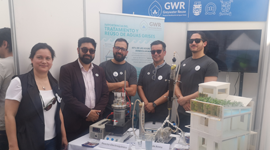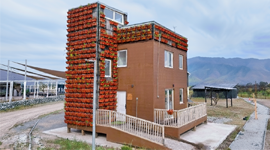You are here
A GWR researcher provides insight on desalination plants

The impact of seawater extraction on the ecosystem and marine biodiversity has been a primary concern in the use of desalination plants to address the water crisis.
In this regard, the release of brine or the catchment process are among the impacts of the desalination process, as explained by Laura Ramajo, a researcher at the Center for Climate Science and Resilience (CR2). "When the brine is released into the sea, it results in an increase in salinity in the local area".
"Salinity levels are crucial for organisms, as most are adapted to specific levels, with minimal variation", the researcher explains. "When these changes persist, organisms experience what is referred to as "osmotic stress".
The organisms most affected are those inhabiting the sandy substrate. Due to its density, the brine "settles on the bottoms, notably affecting the benthic fauna such as mollusks and crustaceans, as well as bottom fish", according to Laura Farías, an academic from the Oceanography Department of the Universidad de Concepción (UdeC) and a researcher at the Millennium Institute in Coastal Socio-Ecology (Secos).
Fortunately, given the current volume of water processed and the projects under construction, "the effects of general scope will not be seen in the short term. Experts indicate that hydrological cycles operate on time scales of tens of thousands of years", says Dr. Julio Romero, an academic in the Department of Chemical Engineering and Bioprocesses at Usach, emphasizes the continued relevance of promoting local research on these effects and managing the locations of the plants according to the environmental conditions of each territory.
Mitigation measures
Aware of the need for responsible operations, “desalination plants currently have oceanographic models, environmental monitoring plans, videos and scientific studies of the biota in the surroundings of the discharges and immisaries, which show the life that develops around these underwater installations”, explains Rafael Palacios, executive vice-president of the Chilean Desalination Association (Acades). The areas of influence reached by the brine discharge in plants such as those in Antofagasta, Copiapó, Caldera or Tocopilla, he adds, are areas similar to or smaller than a tennis court, so that “in no case do the saline plumes reach the coast, since at approximately 10 meters from the discharge there are differences of less than 5% of salinity with the environment”.
"As technology has evolved and various innovations have been introduced, the environmental effects of desalination plants are compatible with marine flora and fauna", says Waldo López, Acciona's Water Business Development Manager. He also points out that energy consumption is low compared to other production processes. "Producing a thousand liters of water requires the same amount of energy as three hair dryers operating for an hour", he explains.
Javier Moreno, the general manager of Aguas Pacifico, a desalination company, has stated that there is a significant amount of misinformation regarding brine management. "The process's function is to extract the salt from the seawater, yielding fresh water, and then return water with a higher salt concentration to the sea. We do not incorporate any additional elements, nor do we contaminate the water that is returned to the sea", he points out.
Moreno has stated that the primary objective of their operations is to achieve zero net loss of biodiversity. To this end, they have implemented a program to monitor salinity levels, a non-suction intake system to protect bay species, and a set of diffusers that facilitate the rapid dilution of wastewater.
Challenges
Despite these advances, Alejandra Stehr, a UdeC academic and advisor to the Infrastructure Policy Council (CPI), emphasizes the necessity of site-specific evaluation of all mitigation measures. She clarifies that there are no established standards, as the suitability of a site for brine discharge determines the necessary measures.
According to Cristian Chadwick, director of the Diploma in Hydrology and Impacts of Climate Change and academic of the Faculty of Engineering and Sciences at the UAI, some of the challenges include ensuring that the brine is fully dissolved when it returns to the sea and evaluating the cumulative impact of all desalination plants operating in a sector.
Source: Diario Financiero
News
 GWR project at the Environmental Fair
GWR project at the Environmental Fair
 GWR researcher participates in major science conference in Portugal
GWR researcher participates in major science conference in Portugal
 The GWR Project has achieved the technological integration of gray...
The GWR Project has achieved the technological integration of gray...

